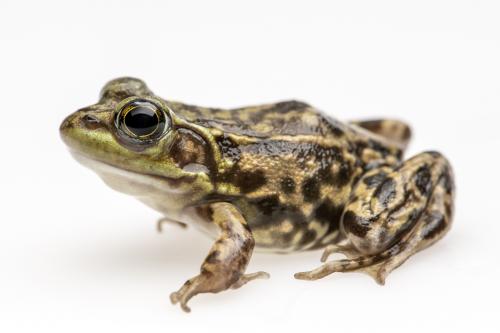
Scientific name: Lithobates septentrionalis
Mi’kmaq Translation: To be Confirmed
French Translation: Grenouille du Nord
Gaelic Translation: Losgann-mionc
Physical Description
Mink Frogs are olive green to brown, often with dark spots along the back, sides and legs. The belly is white with pale yellow on the sides. The toes on the front legs are unwebbed. The back legs are webbed, with the webbing reaching the last joint on the longest (4th) toe. The tympanum (ear drum) on the male is noticeably larger than their eye, while the female tympanum is about the same size. Newly hatched tadpoles (larvae) are legless with long tails. They are brown to green with dark spot and yellow bellies. The call of the Mink Frog is a quick series of croaks. It’s been described as sounding like a hammer tapping on wood.
Size
Newly developed young range from 2.8 to 4.2cm in length
Adult males range from 4.9 to 6.8cm in length
Adult females range from 5.4 to 7.0cm in length
Range and Distribution
Mink Frogs can be found in eastern Manitoba and Ontario east to several Maritime Provinces. In Nova Scotia, they are in various population pockets around the mainland and Cape Breton Island.
Habitat
These frogs are highly aquatic. They prefer slow and quiet water bodies with plenty of plants like lily pads and pickerel weed. It is very rare to see them on land. Wetlands, lakes, ponds and rivers make the best habitats for Mink Frogs. Permanent water habitats are needed for breeding and hibernation.
Diet
Mink Frogs forage for food during the day. They eat a variety of land and water invertebrates found in and around aquatic plants. Common prey includes ants, beetles, spiders and water striders, slugs and dragonflies.
Reproduction and Life Cycle
Mink Frogs emerge from hibernation in early spring. They are active between late April and October. Breeding season happens from June to August, and a process called amplexus is used. This is when the male uses his front leg to grab the females' body, causing her to release the eggs, which are fertilized externally. Breeding males can be recognized from females by the swollen base of the thumbs on their front legs. Females release up to 2,000 eggs in a large, jelly-like mass. This mass is attached to submerged vegetation that is at least 1m below the surface. The eggs hatch in less than two weeks. Tadpoles (larvae) will develop into adults after one to two years. They overwinter as tadpoles and begin their transformation the following summer. Sexual maturity is reached one to two years after they’ve developed into adults. Mink Frogs have a life span of up to six years after their development from tadpole to adult.
Status
NSESA: No Status
COSEWIC: Not Assessed
Threats
Their populations are believed to be stable, but the loss of wetland and shoreline habitats do pose significant threats to Mink Frogs. Other factors like climate change, pollution, road mortality, and the use of the herbicides and pesticides also pose long-term health risks for these frogs.